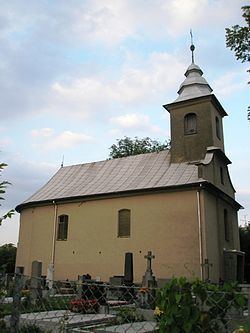Postal code 739 59 Elevation 365 m Local time Thursday 8:46 AM | First mentioned 1305 Website obecstritez.cz Area 6.15 km² Population 1,007 (2006) | |
 | ||
Weather 9°C, Wind NW at 11 km/h, 87% Humidity | ||
Střítež (Polish: Trzycież , German: Trzytiesch) is a village in Frýdek-Místek District, Moravian-Silesian Region, Czech Republic. It has a population of 996 (2001 census), 18.8% of the population are the Poles. Ropičanka River flows through the village. The village lies in the historical region of Cieszyn Silesia.
Contents
Map of 739 59 St%C5%99%C3%ADte%C5%BE, Czechia
Etymology
The origins of the name are dubious. If the original name of the village was Trzeciesz it could have been patronymic in origin derived from personal name Trzeciech. Czech scribing can be related to common local names Střítež denoting damp places vegetated by deergrass. According to A. Bańkowski the name is derived from Old Polish czrzecież, equivalent to Old Czech form denoting rather hack and slash than reed (Polish: trzcina).
History
The village was first mentioned in a Latin document of Diocese of Wrocław called Liber fundationis episcopatus Vratislaviensis from around 1305 as item in Trezhes. It meant that the village was in the process of location (the size of land to pay a tithe from was not yet precised). The creation of the village was a part of a larger settlement campaign taking place in the late 13th century on the territory of what will be later known as Upper Silesia.
Politically the village belonged initially to the Duchy of Teschen, formed in 1290 in the process of feudal fragmentation of Poland and was ruled by a local branch of Piast dynasty. In 1327 the duchy became a fee of Kingdom of Bohemia, which after 1526 became part of the Habsburg Monarchy.
The village became a seat of a Catholic parish, mentioned in the register of Peter's Pence payment from 1447 among 50 parishes of Teschen deanery as Stzreczicz. After the 1540s Protestant Reformation prevailed in the Duchy of Teschen and a local Catholic church was taken over by Lutherans. It was taken from them (as one from around fifty buildings in the region) by a special commission and given back to the Roman Catholic Church on 23 March 1654. The parish is now served by the Saint Archangel Michael Church.
After Revolutions of 1848 in the Austrian Empire a modern municipal division was introduced in the re-established Austrian Silesia. The village as a municipality was subscribed to the political and legal district of Cieszyn. According to the censuses conducted in 1880, 1890, 1900 and 1910 the population of the municipality grew from 582 in 1880 to 614 in 1910 with a majority being native Polish-speakers (between 92.9% and 96.6%) accompanied by a German-speaking minority (at most 39 or 6.6% in 1900) and Czech-speaking (at most 7 or 1.2% in 1890). In terms of religion in 1910 the majority were Roman Catholics (54.7%), followed by Protestants (43.5%) and Jews (11 or 1.8%). The village was also traditionally inhabited by Cieszyn Vlachs, speaking Cieszyn Silesian dialect.
After World War I, fall of Austria-Hungary, Polish–Czechoslovak War and the division of Cieszyn Silesia in 1920, it became a part of Czechoslovakia. Following the Munich Agreement, in October 1938 together with the Zaolzie region it was annexed by Poland, administratively adjoined to Cieszyn County of Silesian Voivodeship. It was then annexed by Nazi Germany at the beginning of World War II. After the war it was restored to Czechoslovakia.
